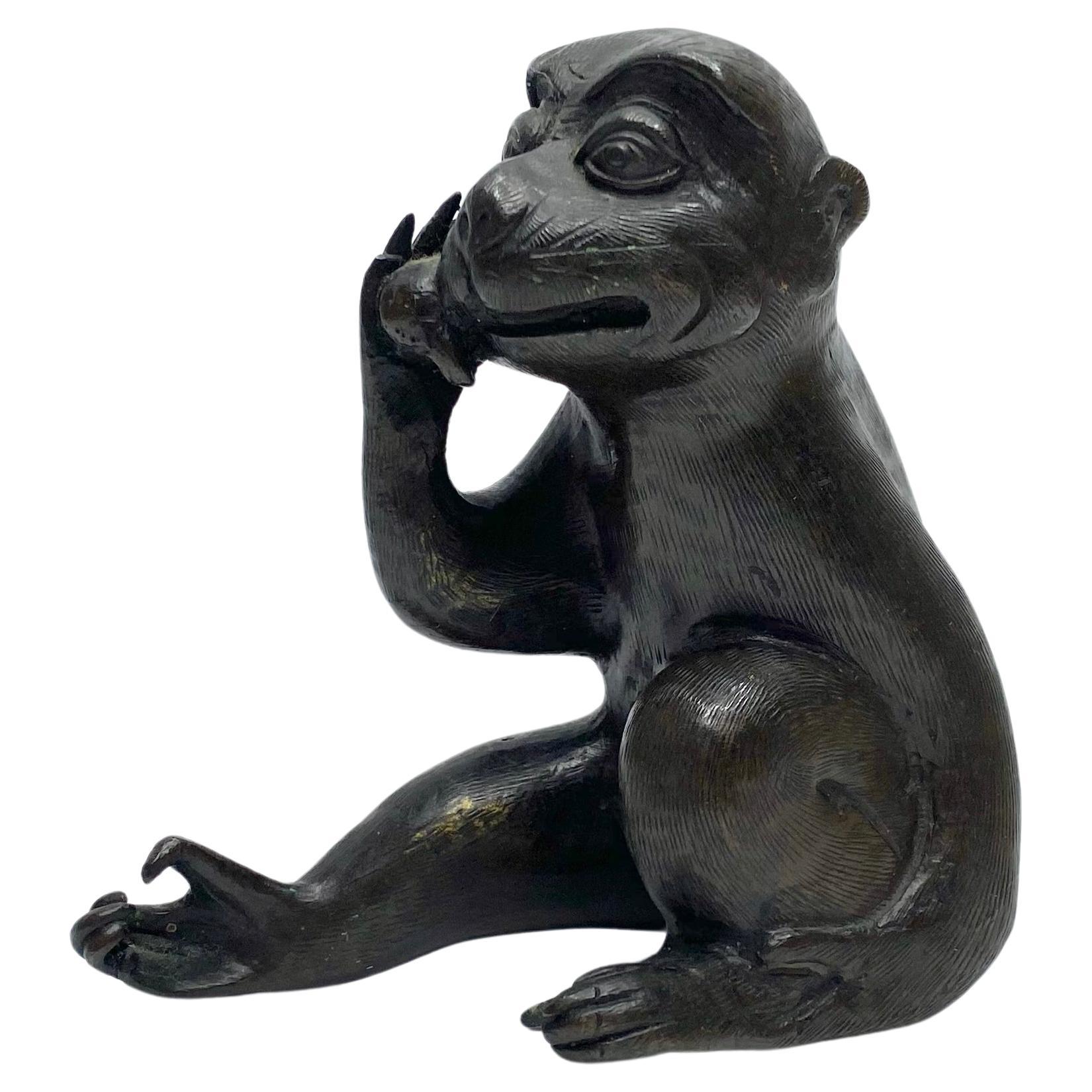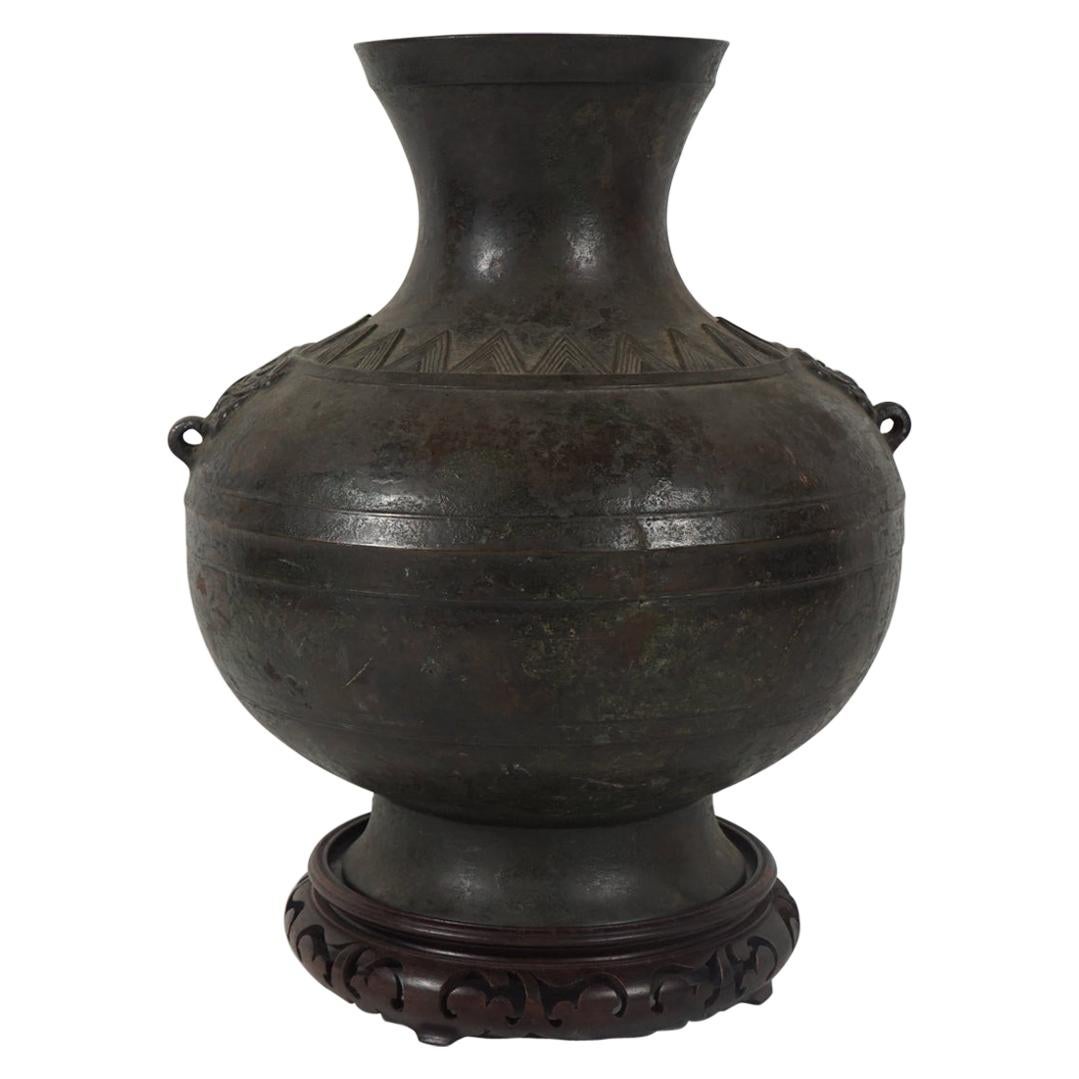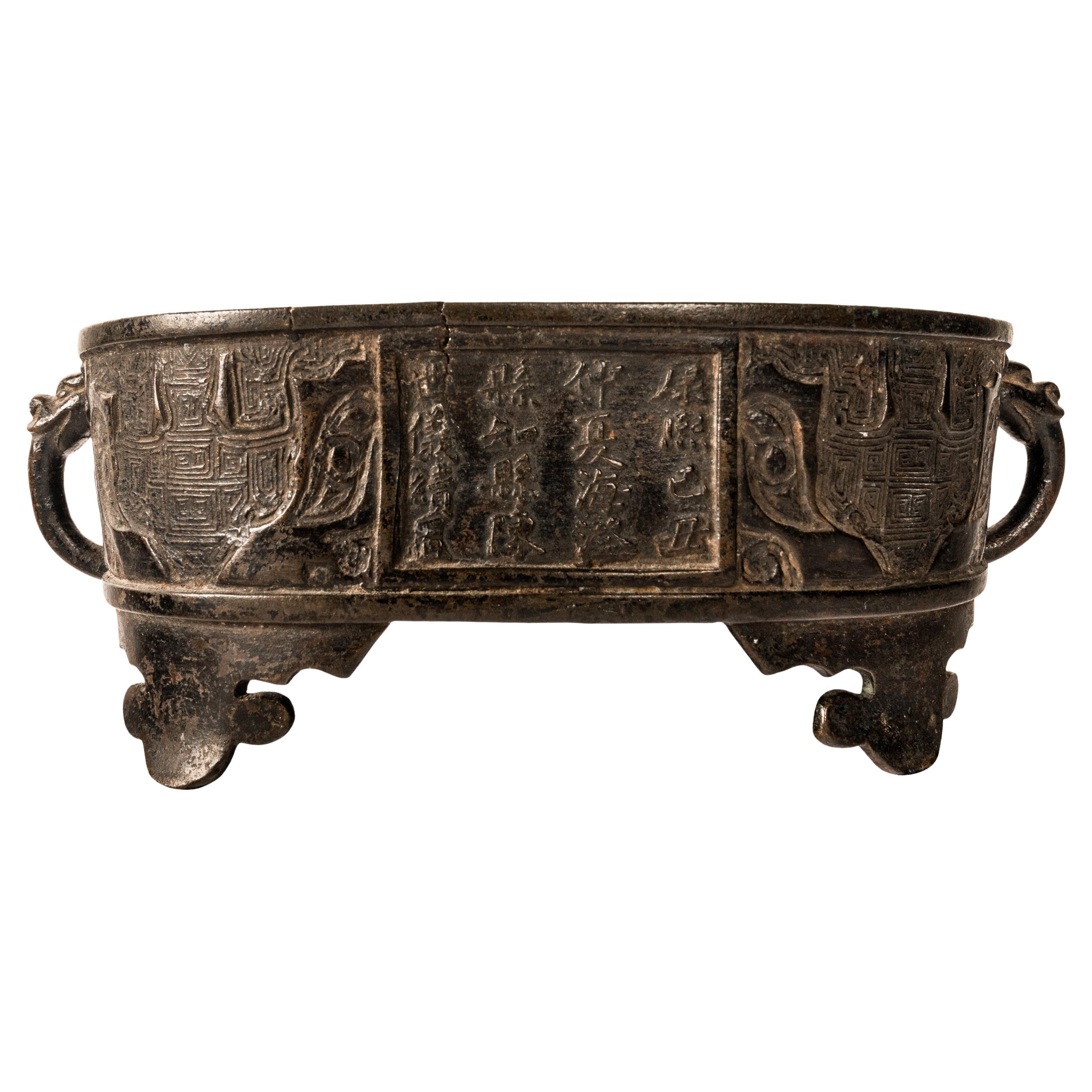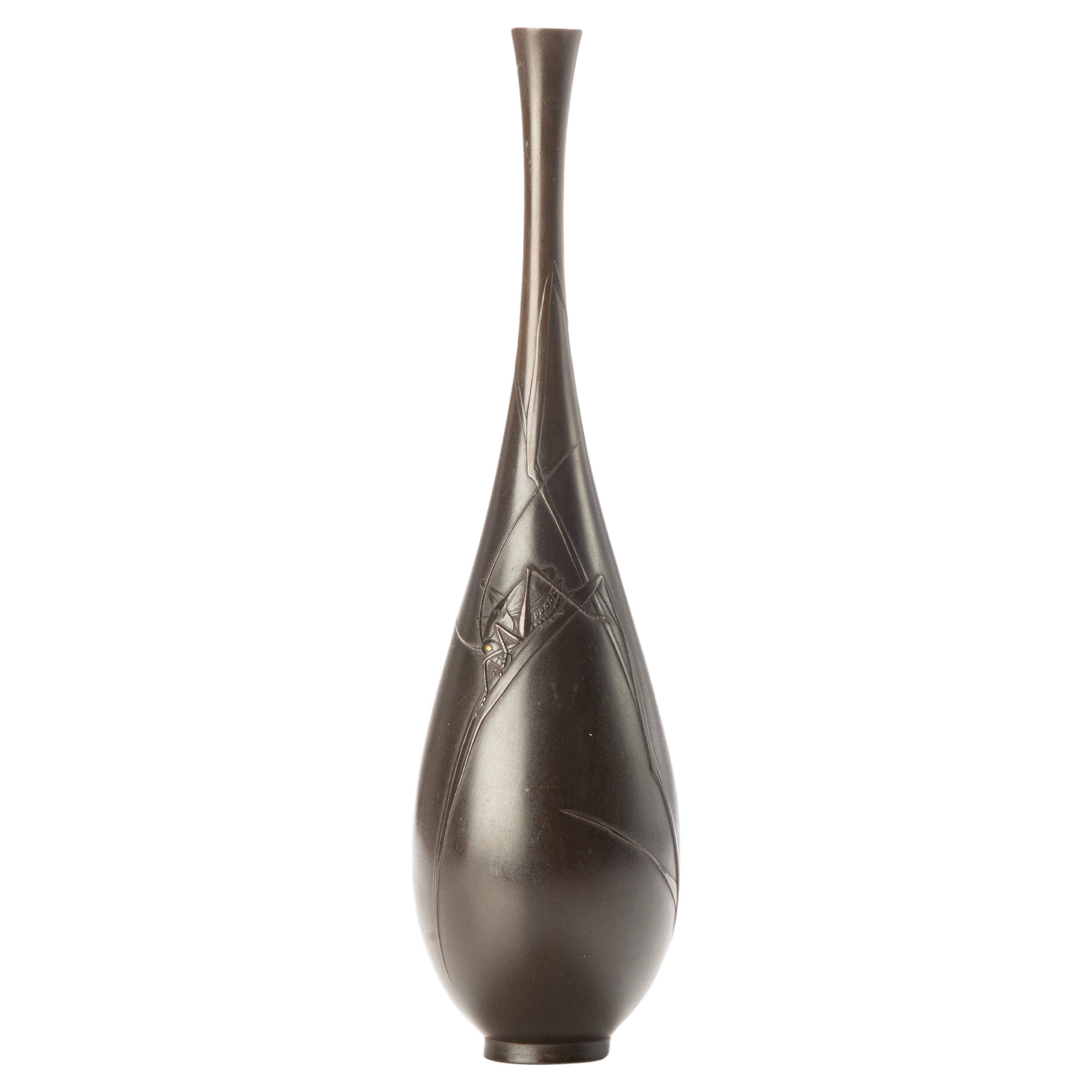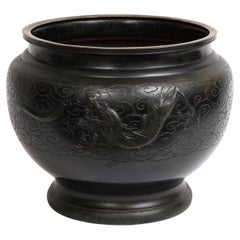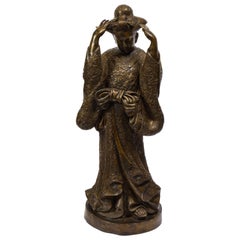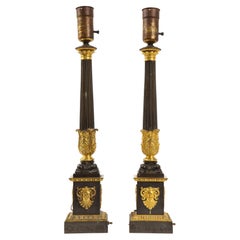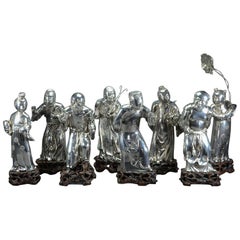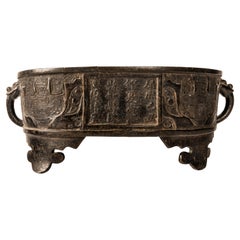Items Similar to A Ming Dynasty Patinated Bronze Relief Work Vase Turned to a Lamp
Want more images or videos?
Request additional images or videos from the seller
1 of 16
A Ming Dynasty Patinated Bronze Relief Work Vase Turned to a Lamp
About the Item
Hailing from the Ming period in 16/17th century, this monumental bronze vase is a fine example of the auspicious decor and markings unique to Chinese furnishings. The vase is cast with taotie masks, the basin is impressed with religious symbolism, and the handles act as two opposing dragons. The various patterned elements on this vase encompass popular Chinese bronze casting and relief carving motifs. This vase was later turned to a lamp without the need of comprimising the original piece. The bronze vase is in original condition with minimal ware.
This particular vase is an ancient Chinese Zun, a ritual wine vessel characterized by a flared opening and bulging midsection. The outside of the vase features a high and low relief decoration that is significant to Chinese symbolism. Along the neck is a relief of twirling, whipping clouds: the winds of chi’i. On the large relief on the basin, there is a relief decoration with archaic motifs like taotie masks and stylized dragons. Vases were often made to furnish the tombs of the Chinese elite. Thus, these vessels were imbued with religious symbolism and imagery to evoke otherworldly spirits for good fortune in the afterlife.
Religious symbolism is an important aspect of this vase. The winds of chi’i on the neck represent the energy of the universe, while the dragon handles symbolize great power and strength. The taotie motif on the basin holds multiple meanings—it has been interpreted as “one of the four evil creatures of the world.” It is commonly represented on Chinese ritual bronze vessels to demonstrate their mystical power and their relationship between humankind and the afterlife.
China, Circa: Ming Dynasty
The Height of the Piece With the Electrical Fitting is: 32 inches and 23 inches Without the Electrical Fitting
- Dimensions:Height: 23 in (58.42 cm)Width: 12 in (30.48 cm)Depth: 9 in (22.86 cm)
- Style:Ming (Of the Period)
- Materials and Techniques:Bronze,Patinated
- Place of Origin:
- Period:
- Date of Manufacture:Ming Dynasty
- Condition:Wear consistent with age and use.
- Seller Location:New York, NY
- Reference Number:1stDibs: LU919538603142
About the Seller
4.9
Platinum Seller
These expertly vetted sellers are 1stDibs' most experienced sellers and are rated highest by our customers.
Established in 1820
1stDibs seller since 2011
160 sales on 1stDibs
Typical response time: <1 hour
- ShippingRetrieving quote...Ships From: New York, NY
- Return PolicyA return for this item may be initiated within 1 day of delivery.
Authenticity Guarantee
In the unlikely event there’s an issue with an item’s authenticity, contact us within 1 year for a full refund. DetailsMoney-Back Guarantee
If your item is not as described, is damaged in transit, or does not arrive, contact us within 7 days for a full refund. Details24-Hour Cancellation
You have a 24-hour grace period in which to reconsider your purchase, with no questions asked.Vetted Professional Sellers
Our world-class sellers must adhere to strict standards for service and quality, maintaining the integrity of our listings.Price-Match Guarantee
If you find that a seller listed the same item for a lower price elsewhere, we’ll match it.Trusted Global Delivery
Our best-in-class carrier network provides specialized shipping options worldwide, including custom delivery.More From This Seller
View AllA Japanese Meiji Period Patinated Bronze Centerpiece/Bowl w/ Dragon in Relief
Located in New York, NY
A Fantastic and large Japanese Meiji Period Patinated Bronze Centerpiece/Bowl/jar denier with Dragon in Relief. This captivating and exquisite, hand-crafted, patinated bronze centerpiece serves as a remarkable focal point, adorned with marvelously hand-chassed and hand-chiseled dragons in relief, gracefully emerging and disappearing behind artfully stylized scrolling etched clouds. The centerpiece boasts a substantial and graceful curved base, complemented by a striking peaked and square-edged lip atop the vessel.
The significance behind the depiction of the three-clawed dragons stems from the Japanese belief that Eastern dragons originated within their native land. According to their folklore, as these majestic creatures ventured away from Japan, they acquired additional toes. The Japanese Sky dragon...
Category
Antique 1890s Japanese Meiji Metalwork
Materials
Bronze
French Patinated Bronze Figure of a Standing Japanese Geisha with Kimono & Obi
Located in New York, NY
A beautiful French patinated bronze figure of a standing Japanese geisha in a traditional kimono with an obi. This geisha is exceptionally cast with immense detail. Starting from the...
Category
Early 20th Century French Japonisme Figurative Sculptures
Materials
Bronze
Pr. French Empire Period Patinated & Dore Bronze Candlesticks Turned to Lamps
Located in New York, NY
A fantastic pair of French empire period patinated and dore bronze candlesticks mounted as lamps. Each is beautifully cast, hand-chased, and hand-chiseled with the finest quality of burnished and matted dore bronze mounts. The fluted columnar bodies are beautiful with a dark patina which is offset with magnificent rich dore bronze mounts. The bodies are fluted with acanthus leaf dore bronze mounts which terminate at either end. The tops are supported by multiple patinated bronze lions paws. The bases are square with dore bronze medusa...
Category
Antique 19th Century French Empire Table Lamps
Materials
Bronze
Silver Figures of Eight Immortals Yangqinghe Jiuji Marks, Late Qing Dynasty
Located in New York, NY
Important and rare silver figures of eight immortals Yangqinghe Jiuji marks, Late Qing dynasty. Each hollow figure portraying one of the immortals in an animated pose, with highly detailed facial features, four pierced with apertures for the insertion of facial hair, clad in finely chased robes, all but two with their characteristic attributes, their bases bearing either two seal marks reading Yangqinghe Jiuji gongyibu and Zhe'ning Hu Qiusheng zao, or three marks in regular script reading Yangqinghe Jiuji gongyibu, Shang and Sheng zuo, original hand-carved wood stands. Measures: 11 1/4in (28.5cm) high (tallest one).
The earliest records of the silver atelier known as Yangqinghe date to 1775 in Shanghai...
Category
Antique 1890s Chinese Chinese Export Metalwork
Materials
Silver
18th/19th Century Mughal Dynasty Gold and Gem Encrusted Jade Dagger
Located in New York, NY
Mughal dynasty gold and gem encrusted Spinach jade dagger having a dark green pistol grip, inlaid with gold, ruby and sapphire applied rosettes to either s...
Category
Antique 19th Century Indian Islamic Metalwork
Materials
Jade, Steel
Japanese Meji Period Mixed Metal Plaque Attb. to Suzuki Chokichi 'Kaka'
Located in New York, NY
A large, fine quality, and world class Japanese Meiji period mixed metal plaque with Shakudo-inlay, silver-inlay, gold-inlay, copper-inlay, and patina, attributed to the famous Suzuki Chokichi...
Category
Antique 19th Century Japanese Meiji Metalwork
Materials
Metal, Gold, Silver, Copper
You May Also Like
Chinese bronze Monkey, 17th Century, Ming Dynasty.
Located in Gargrave, North Yorkshire
Chinese bronze figure of a Monkey, 17th Century, Ming Dynasty. The amusing study, cast as a seated monkey, about to devour a peach, held in his r...
Category
Antique 17th Century Chinese Ming Metalwork
Materials
Bronze
Ming Dynasty Period Cast Bronze Hue Shaped Urn in an Archaist Style
Located in Hudson, NY
This fine old urn cast as an honorific nod to the ancient past of China was made circa 1600-1650. The shape or Hue was a common and well-represented form in the Han dynasty in pottery and bronze. This urn shows thin casting to the walls with incorporated toe tia or facial masks...
Category
Antique Mid-17th Century Chinese Ming Metalwork
Materials
Bronze
Chinese Bronze Scholar Vase with Taotie, Ming/Qing Dynasty, 17th century, China
Located in Austin, TX
A small and interesting cast bronze archaistic scholar vase with loose ring handles and taotie mask design, late Ming or early Qing Dynasty, mid 17th century, China.
The small vase of archaistic hu form, and cast with archaistic designs. Sitting on a tall splayed ring foot, the round body is cast with a large band featuring a ferocious taotie (ogre) mask. The taotie mask in this case id decidedly feline, with a ruyi shaped snout above a whiskered mouth. Two flanges stick out to either side of the mask, reminiscent of ears.
A wide, tall neck rises from the body, terminating in a slightly everted mouth. The archaistic cast design on the neck is not as clear, but most likely represents Fusang, a mythical island in the Eastern Sea where the legendary Fusang tree grows. The Fusang tree, home to the mythical Sun Bird...
Category
Antique Mid-17th Century Chinese Qing Scholar's Objects
Materials
Bronze
Antique Archaic Zhou Dynasty Style Chinese Bronze Censer Incense Burner Ming
Located in Portland, OR
A good antique Chinese Zhou dynasty style archaistic bronze censer, incense burner.
This cast bronze censer is in the archaic Zhou dynasty style, but believed to be more likely from ...
Category
Antique 17th Century Chinese Archaistic Metalwork
Materials
Bronze
A Japanese patinated bronze vase depicting a cricket
Located in Milano, IT
A slender shape patinated bronze vase depicting a naturalistic scene of a cricket sitting on iris leaves.
Signed Joun in relief within an oval reserve.
Origin: Japan
Period: Meiji ...
Category
Antique Late 19th Century Japanese Japonisme Metalwork
Materials
Bronze
Pair Large Meiji Japanese Patinated Bronze Vases
Located in New York, NY
Pair of fine Meiji period Japanese patinated bronze vases distinguished by their stylized elephant form handles, cartouches depicting exotic birds and dragon encircling the base. 22...
Category
Antique Late 19th Century Japanese Meiji Metalwork
Materials
Bronze
$3,500 / set
